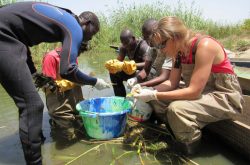
Satellite images, drone photos and even Google Earth could help identify communities most at risk for getting one of the world’s worst tropical diseases.
A team led by the University of Washington and Stanford University has discovered clues in the environment that help identify transmission hotspots for schistosomiasis, a parasitic disease that is second only to malaria in its global health impact. The research, published Oct. 28 in the Proceedings of the National Academy of Sciences, uses rigorous field sampling and aerial images to precisely map communities that are at greatest risk for schistosomiasis.
“This is a game-changer for developing-country public health agencies, because it will make it possible for them to efficiently find the villages that need their help the most,” said lead author Chelsea Wood, an assistant professor in the UW School of Aquatic and Fishery Sciences.
More than 200 million people have schistosomiasis, which is treatable but has been difficult to eliminate from some regions of the world. Schistosomes, the worms that cause this disease, grow within freshwater snails, where they multiply and are released into the waters of rivers, lakes and streams. The worms infect people by penetrating their skin when they swim, bathe or wade. Schistosomiasis causes bloody urine and stool and abdominal pain, and can damage the liver, spleen, intestines, lungs and bladder. In children, the infection can stunt growth and impair cognitive development.
Read more at UW News »
